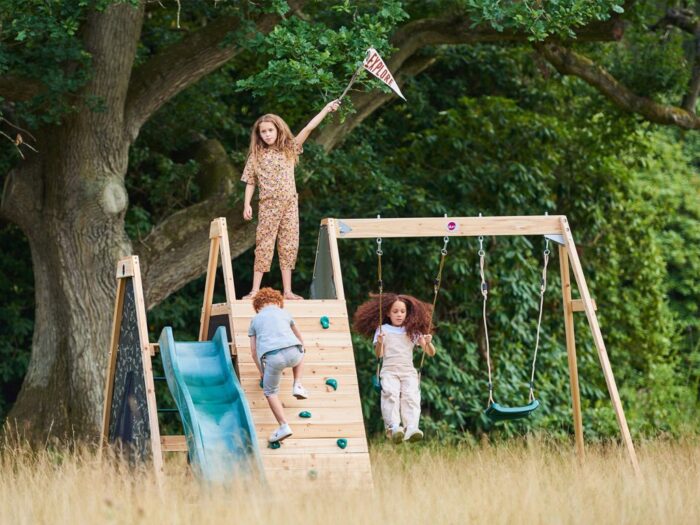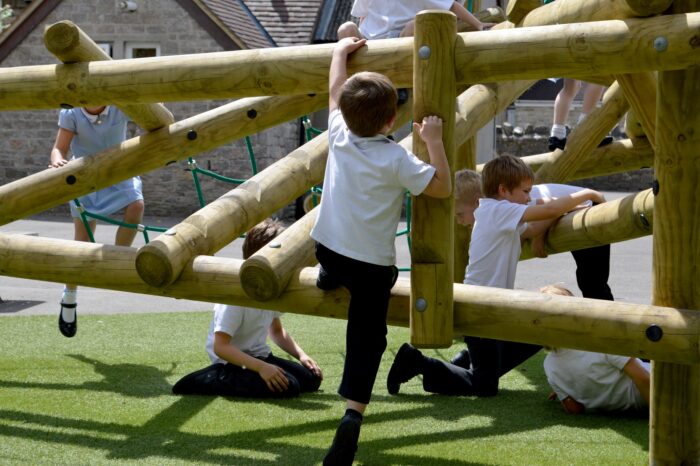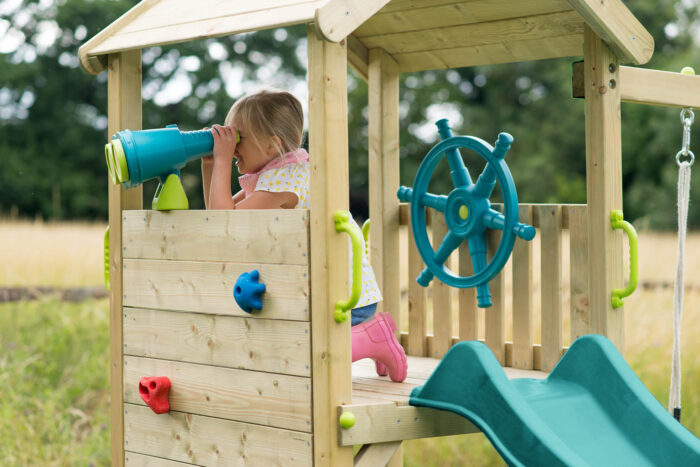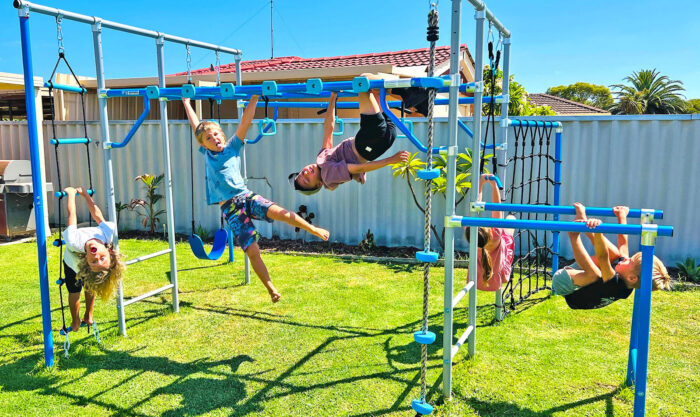
We all fondly remember the games we used to play as little children, whichever play equipment we may have had at our disposal – even if it was only our imaginations!
However, not everyone knows that there are distinct types of play that contribute to every child’s development – or that some play equipment can fulfill all of them.
Climbing frames offer a cost-effective solution to combining various types of play apparatus into the same space-saving structure, providing multiple ways to play in one place.
Here’s how the different elements in a kids’ climbing frame can encourage learning and development through different styles of play.
Physical Play

The most obvious type of play that climbing frames support is physical play. This includes any activity that gets children physically moving, from running and jumping to climbing and swinging.
Physical playing helps children to get the exercise they need to develop healthy muscles and joints, while also developing their fine and gross motor skills through regular practice.
Monkey bars, nets, rock walls, and firefighter poles encourage a strong grip and exercise the upper body and arms, while steps, swings, and slides require pushing, jumping, and leg movements.
- Muscle Strength and Endurance: Climbing frames require children to use their muscles to climb, swing, and balance. This helps develop their muscle strength and endurance, promoting a healthy and active lifestyle.
- Coordination and Balance: Climbing frames challenge children to coordinate their movements and maintain balance, enhancing their motor skills. These skills are crucial for activities like riding a bike, playing sports, and even handwriting.
- Cardiovascular Health: Engaging in activities on climbing frames gets children moving and increases their heart rate, contributing to better cardiovascular health.
Constructive Play
Another essential part of play development is constructive play. This involves using available materials or objects to create or build something different.
For example, if a climbing frame comes with a sandpit or has an open space under a tower or bridge, they could build sandcastles or create a hidden den with blankets.
This helps children to develop their hand-eye coordination and logical thinking, sparking their curiosity about the world around them and understanding concepts like size and distance.
Cognitive Development

Climbing frames also support cognitive development in various ways:
- Problem-Solving: Children must figure out how to navigate the climbing frame safely, encouraging problem-solving skills and critical thinking.
- Spatial Awareness: Climbing frames require an understanding of space and distance, helping children develop spatial awareness, an essential skill in mathematics and everyday life.
- Risk Assessment: As children explore the climbing frame, they learn to assess risks and make decisions about what actions are safe and appropriate.
Imaginative Play
Also known as dramatic play or fantasy play, imaginative play helps children to become creative and well-rounded individuals through imagining themselves in different situations.
They can play pretend at something ordinary, like being a doctor, firefighter, or shop worker, or venture into a fantasy land beyond just mimicking the real world they see every day.
Climbing frames allow kids to play house, pretend to be princesses and knights in a castle, pirates on a ship, fairies and elves in a treehouse, or anything else they can dream up. Imaginative games can be aided with accessories like steering wheels, periscopes, telephones, and crawl tubes.
Social Play

Playing together with other kids – whether it’s physical, constructive, imaginative, or a mix of play styles – is vital for any child to learn social skills and build their self-esteem.
Social play encourages children to learn to share, taking turns and using language to express themselves and solve problems, and to be confident enough to assume leadership of games.
This can take the form of parallel play, where children play separately on different apparatus on the climbing frame; cooperative play, where kids have to work together to achieve a creative goal; or competitive play, where they each try to be the best at climbing or swinging.
Social Development
Climbing frames provide opportunities for social interaction and development:
- Cooperation: Children often play together on climbing frames, which fosters cooperation, teamwork, and negotiation skills.
- Communication: Through play, children learn to communicate their ideas, negotiate rules, and resolve conflicts with their peers.
- Empathy and Sharing: Sharing a climbing frame teaches children about empathy and sharing, valuable life skills that help build positive relationships.
Emotional Development

Climbing frames also contribute to emotional development:
- Confidence Building: As children conquer challenges on the climbing frame, they gain confidence in their abilities and become more willing to try new things.
- Independence: Climbing frames provide a safe space for children to explore independently, fostering a sense of autonomy and self-reliance.
- Resilience: Encountering occasional setbacks or falls while using climbing frames can teach children resilience and perseverance.
Sensory Stimulation
Climbing frames engage multiple senses:
- Visual Perception: Children develop visual perception skills by assessing the height, distance, and depth of the climbing frame elements.
- Tactile Sensations: Climbing frames offer various textures and materials, providing tactile stimulation for sensory development.
- Auditory Input: Play on climbing frames often includes laughter and social chatter, contributing to auditory sensory experiences.
In conclusion, climbing frames are more than just play equipment; they are powerful tools for child development. They promote physical fitness, cognitive growth, social skills, emotional well-being, and sensory exploration.
Parents, caregivers, and educators should encourage children to engage with climbing frames as part of their playtime, recognizing the numerous benefits they offer for holistic child development.
Kids’ Climbing Frames for Play Development

With so many features available in one play center, a climbing frame is a perfect way to encourage as many types of play as possible and aid child development.
Of course, children’s play still needs to be supervised, but climbing frames allow kids to explore independently, getting plenty of exercise and spending much-needed time outdoors.
There are lots of different models to choose from, so it should be easy to find one that suits the interests, abilities, and age/size limits of your child.
Best of all, you could find a kids’ climbing frame with customizable apparatus combinations, allowing you to remove features and add new ones as your child grows – continuing to support their development as they get older.














